Artichokes Plant
- March 15, 2024
- 0 comment
Artichokes Plant, scientifically named Cynara scolymus, is a type of thistle that people grow mainly for its tasty flower buds that can be eaten. This plant comes back year after year, so it’s called a perennial plant. It belongs to the sunflower family, known as Asteraceae. People really like this plant because they can use it in cooking and for its health benefits.
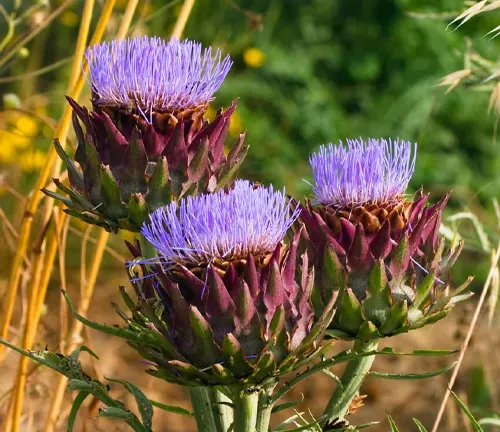
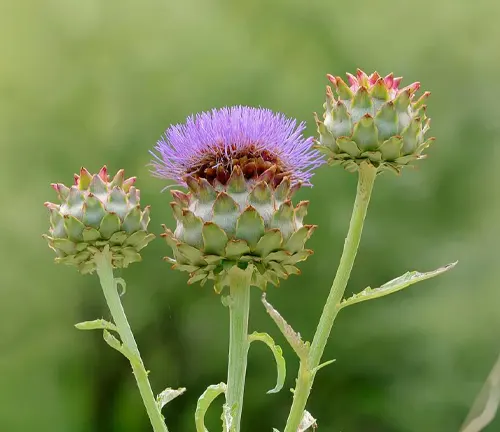
People enjoy eating the flower buds of the Artichoke plant because they taste good and are healthy. They can be cooked in many different ways and are used in various dishes. Additionally, some people believe that the Artichoke plant has medicinal properties, meaning it might have some health benefits when consumed. This makes it not only a delicious addition to meals but also potentially good for your health.
| Characteristics | Description |
| Scientific Name | Cynara scolymus |
| Common Names | Artichoke, Globe Artichoke |
| Family | Asteraceae |
| Native Region | Mediterranean region |
| Plant Type | Perennial |
| Size | Can reach a height of 1.4–2 meters |
| Leaves | Large, deeply lobed, and silvery-green in color |
| Flowers | Violet-blue, thistle-like flower heads |
| Propagation | Primarily through seeds or root division |
| Drought Tolerance | Moderate, prefers well-drained soil |
| Cultural Uses | Widely cultivated for culinary purposes |
| Ecological Role | Attracts pollinators and beneficial insects |
| Notable Species | Cynara cardunculus (Cardoon), Cynara humilis (Globe Artichoke) |
| Hardiness Zones | USDA zones 7-11 |
| Growth Rate | Moderate |
| Lifespan | While Artichokes are perennial, they are often grown as annuals in cooler climates. In optimal conditions, they can produce for about 5 years |
Botanical Beauty of “Artichokes Plant ”
The Artichoke Plant is a special plant that is beautiful to look at, important for the environment, and delicious to eat. Its unique appearance and structure make it stand out in gardens, while its role in nature helps support ecosystems. People also love using it in cooking because of its tasty and versatile edible parts. This plant truly combines beauty, ecological importance, and culinary delight in one package.


Woodland Elegance
The Artichoke Plant’s beautiful silver-green leaves and colorful flower heads add to its charm, making it a favorite choice for decorating gardens and outdoor spaces. Its striking appearance brings a touch of elegance to any landscape, attracting attention and admiration from those who see it. This plant’s unique blend of colors and textures makes it a sought-after ornamental plant, enhancing the beauty of woodland settings and garden landscapes.
Ecological Importance
The Artichoke Plant is an essential plant for the environment because it produces sweet nectar that attracts pollinators like bees and butterflies. These insects help spread pollen between different plants, which is necessary for them to grow and reproduce. By providing a source of food for these pollinators, the Artichoke Plant supports biodiversity in its natural habitats. This means that it helps keep the ecosystem balanced and healthy, ensuring that many different species can thrive together.
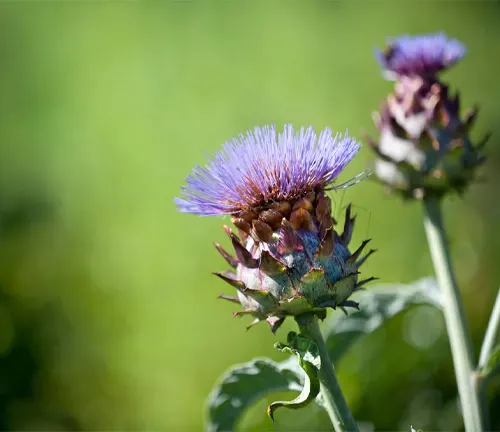

Cultivation and Conservation
Cultivating Artichokes helps farmers grow food in a way that is good for the environment and can be kept up over time. It also helps protect different kinds of Artichokes and keeps a lot of different traits within the plant, which is important for its survival and ability to adapt to changes in the future.
Fragrance
Although the Artichoke Plant is not famous for its fragrance, it still has a gentle, earthy smell that comes from its leaves. This scent adds to the plant’s appeal and makes it even more attractive. While it may not be as strong as some other plants, the subtle aroma of the Artichoke Plant is still a part of its overall charm and allure.
The earthy scent of the Artichoke Plant is a reminder of the natural world and the plant’s connection to the soil. It is a gentle reminder of the plant’s origins and its role in the ecosystem. This subtle fragrance is just one more reason why people enjoy having the Artichoke Plant in their gardens and landscapes.
Soil Stabilization
The strong roots of the Artichoke Plant help keep the soil in place, which is important for preventing erosion and improving the quality of the land. By holding the soil together, these roots help to stabilize the ground and prevent it from washing away during heavy rains or strong winds. This makes the Artichoke Plant a valuable asset for controlling erosion and restoring damaged land.
In areas where soil erosion is a problem, planting Artichokes can be a natural and effective way to protect the land. The deep and robust root system of these plants helps anchor the soil, reducing the risk of erosion and improving the overall health of the land. By choosing to grow Artichokes, individuals can contribute to soil stabilization efforts and support the rehabilitation of degraded landscapes.
Common Uses
Artichokes are not just tasty in recipes; they are also used in traditional medicine for their possible health advantages. Some people believe that Artichokes may help with digestion, liver health, and even lowering cholesterol levels. This dual-purpose plant serves not only as a delicious addition to meals but also as a potential natural remedy for various health concerns.
In traditional medicine, Artichokes have been valued for their medicinal properties, with some studies suggesting they may have antioxidant and anti-inflammatory effects. Whether enjoyed in a meal or consumed for their potential health benefits, Artichokes offer a versatile and beneficial addition to both culinary and wellness practices.
Benefits
Artichokes are considered a “superfood” because they are packed with antioxidants, which are good for your health. These antioxidants help protect your body from damage caused by harmful molecules called free radicals. Additionally, Artichokes are rich in dietary fiber, which is important for digestion and overall gut health. The fiber in Artichokes can help keep you feeling full and support a healthy digestive system.
Moreover, Artichokes have potential medicinal properties that make them even more valuable. Some studies suggest that compounds in Artichokes may help with liver health, digestion, and even cholesterol levels. By including Artichokes in your diet, you can enjoy not only their delicious taste but also their numerous health benefits, making them a great addition to a balanced and nutritious diet.
Different Species
Cynara cardunculus
(Cardoon)
Often considered a cousin to the globe artichoke, the cardoon is grown for its edible stems rather than its flower buds. The plant itself has strikingly similar foliage to the artichoke but with a more pronounced, silvery hue. The cardoon is valued both for its ornamental qualities in gardens and its culinary use, especially in Mediterranean cuisines.
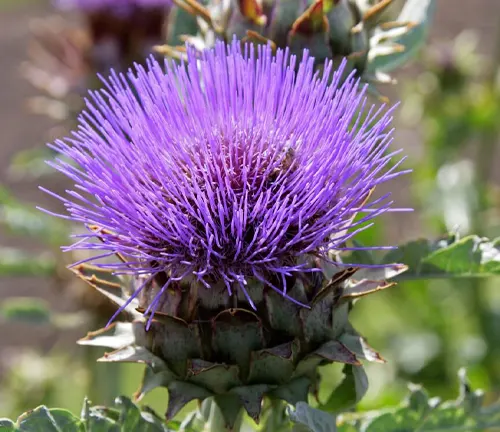
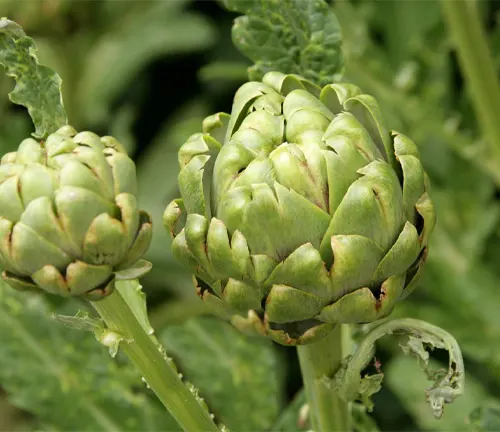
Cynara scolymus
(Globe Artichoke)
This is the species commonly referred to as the artichoke and is cultivated for its large, edible flower buds. The globe artichoke is a staple in Mediterranean diets and is celebrated for its delicate, nutty flavor.
Cynara cornigera
A less commonly known species, this type of artichoke is primarily found in the wild. It has ornamental value and contributes to the biodiversity of the regions where it grows.
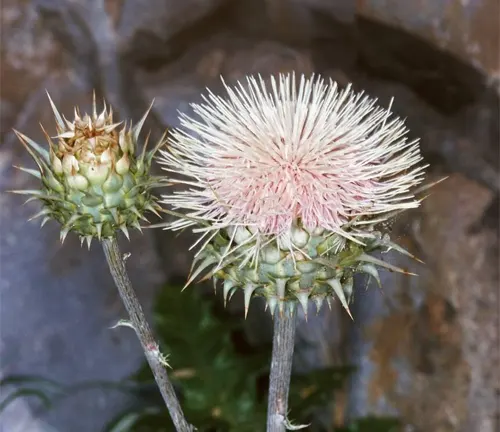
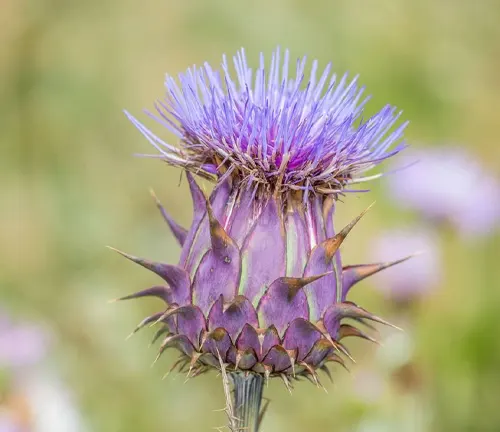
Cynara humilis
This species is known for its adaptability to dry environments and is found in natural settings across the Mediterranean. It has smaller flower buds compared to the globe artichoke and is mostly valued for its ornamental appearance.
Cynara syriaca
Native to the region of Syria, this species is adapted to Middle Eastern climates. It’s less commonly cultivated but has potential as both an ornamental and edible plant in suitable climates.
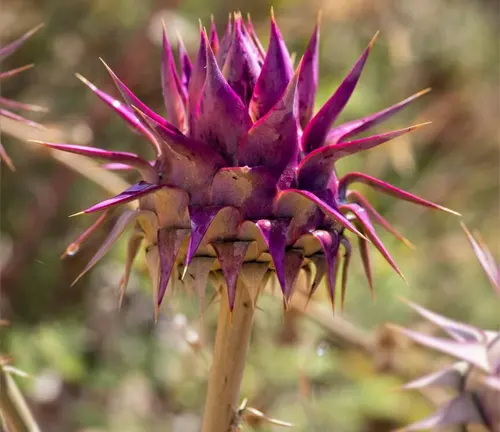
Frequently Asked Questions (FAQs)
1. What is the scientific name for the Artichoke plant?
The scientific name for the Artichoke plant is Cynara scolymus.
2. Can you eat the leaves of an Artichoke plant?
Yes, the leaves of an Artichoke plant are edible. While the heart is the most sought-after part, the base of the larger leaves can be scraped off with your teeth and enjoyed for its flavor.
3. How tall can an Artichoke plant grow?
An Artichoke plant can reach a height of 1.4–2 meters (about 4.6–6.6 feet) in ideal growing conditions.
4. Are Artichokes good for your health?
Yes, Artichokes are considered a superfood. They’re rich in antioxidants, dietary fiber, and contain various compounds believed to support liver health, aid digestion, and potentially lower cholesterol levels.
5. How do Artichoke plants benefit the environment?
Artichoke plants produce nectar that attracts pollinators such as bees and butterflies, supporting biodiversity and helping with the pollination of other plants.
6. What’s the difference between a Globe Artichoke and a Cardoon?
The Globe Artichoke (Cynara scolymus) is cultivated for its edible flower buds, while the Cardoon (Cynara cardunculus) is grown for its edible stems. Both plants are related and have similar foliage but are used differently in the kitchen.
7. Can Artichoke plants grow in any soil type?
Artichoke plants prefer well-drained soil but are relatively adaptable to different soil types. However, they thrive best in nutrient-rich, loamy soil.
8. How often should you water Artichoke plants?
Artichoke plants need regular watering to keep the soil consistently moist but not waterlogged. They require more frequent watering in dry and hot conditions.
9. Do Artichoke plants have a fragrance?
While not known for a strong fragrance, Artichoke plants can emit a subtle, earthy aroma from their leaves, contributing to their overall sensory appeal.
10. Are there different species of Artichoke plants?
Yes, besides the commonly cultivated Globe Artichoke (Cynara scolymus), there are other species like Cynara cardunculus (Cardoon), Cynara cornigera, Cynara humilis, Cynara syriaca, and Cynara tournefortii, each with unique characteristics and adaptability to various environments.



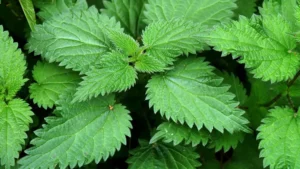

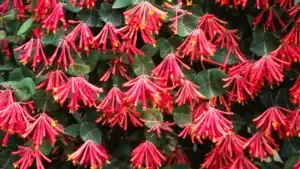


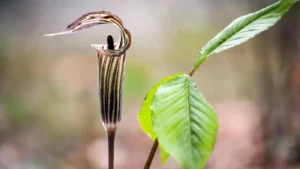



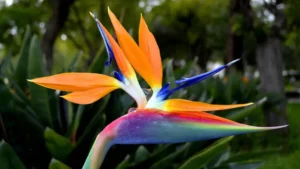

Leave your comment